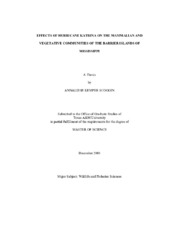| dc.description.abstract | The barrier islands of the gulf coast of the U.S. have been shaped and changed by hurricanes for centuries. These storms can alter the vegetation of the barrier islands by redistributing sediments, scouring off vegetation, physical damage to the plants, and by salt stress following the storm. Hurricanes also alter the mammal communities of the barrier islands through direct mortality and by altering vegetative communities.
It is important to understand how the vegetation of barrier islands recovers after major hurricanes because the vegetation provides the structure that maintains and builds these islands. Following the landfall of Hurricane Katrina in August of 2005, I studied the changes in the herbaceous ground cover and the density of woody plants in Gulf Islands National Seashore in Mississippi from the winter of 2005 to the summer of 2007. Growth from existing plants and seed banks quickly revegetated the islands after the storm. The amount of live ground cover increased and bare ground decreased on each island and in every vegetation type. Most woody plant species also showed a net increase in density, with the exception of pine (Pinus elliottii) and Florida rosemary (Ceratiola ericoides). The regeneration of woody species and the uniform increase in the live ground cover seemed to indicate that the vegetation of the islands was not irreversibly impacted.
I also studied the changes in the composition of mammal populations in Gulf Islands National Seashore from the winter of 2005 to the summer of 2007. Prior to the storm 11 terrestrial mammal species were recorded in studies of the barrier islands. In the 2 years following Hurricane Katrina, I recorded only 1 of the 7 species on Cat Island, 5 of the 9 species on Horn Island and 2 species each on East Ship, West Ship, and Petit Bois Islands (which previously had 4, 4, and 2 each). Populations of mammals that used multiple vegetation types (raccoons [Procyon lotor], nutria [Myocastor coypus], and eastern cottontail [Sylvilagus floridanus]) seemed to show more tolerance to hurricane disturbance than more specialized species (black rat [Rattus rattus], marsh rice rat [Oryzomys palustris]). I also recorded at least one colonization event by river otter (Lutra canadensis), a species not recently recorded on the islands. This research serves as a baseline for future comparison following similar storms. | en |


